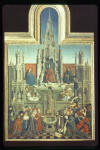|
Van Eyck, Jan (1390?-1441)
"Oil paints facilitated the exactitude
found in the work of van Eyck and others. Although
traditional scholarship credited Jan van Eyck with the invention
of oil painting, recent evidence has revealed that oil paints
were known for some time and that Melchior Broederlam was using
oils in the 1390's. Flemish painters built up their
pictures by superimposing translucent paint layers, called
glazes, on a layer of underpainting, which in turn had been
built up from a carefully planned drawing made on a
white-grounded panel. With the rediscovered medium,
painters created richer colors than previously had been
possible. Thus, a deep, intense tonality; the illusion of
glowing light; and hard, enamel-like surfaces characterized
fifteenth-century Flemish painting. These traits differed
significantly from the high-keyed color, sharp light, and rather
matte surfaces of tempera."
- Gardner's
Art Through The Ages,
11th edition, Vol. II, p. 569
|

|

Fountain of Grace
"Van Eyck rendered the entire altarpiece in a shimmering
splendor of color that defies reproduction. No small
detail escaped van Eyck, trained as a miniaturist.
With pristine specificity, he revealed the beauty of the
most insignificant object as if it were a work of piety as
much as a work of art. He depicted the soft texture of
hair, the glitter of gold in the heavy brocades, the luster
of pearls, and the flashing of gems, all with loving
fidelity to appearance."
- Gardner's
Art Through The Ages,
11th edition, Vol. II, p. 569
|
|
|
|